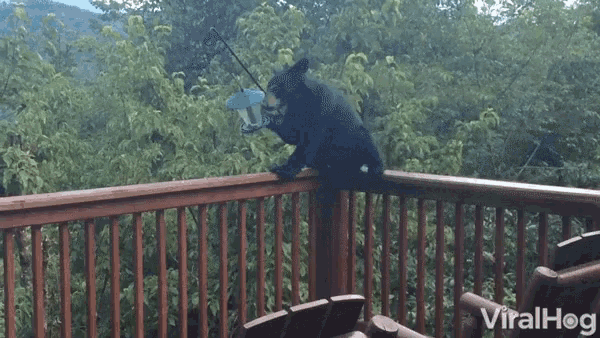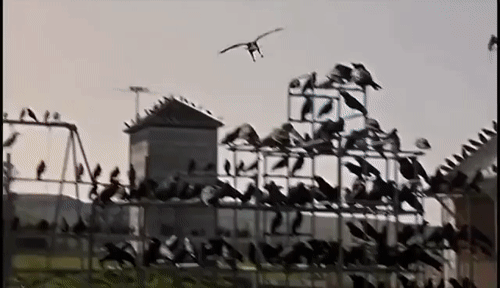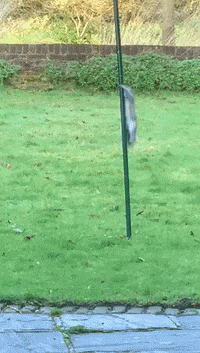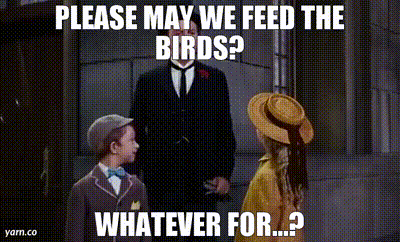Happy Spring, everyone!
I had a minor milestone this week: I passed 2000 Twitter followers. It was actually a weird time to hit this benchmark, as I was feeling ill with a bad migraine cycle and not especially present most of the week. Plus, I’ve fallen behind on scheduled writing questions, the major way I was building engagement, so the people who tipped me over were signing up for my random shower thoughts and earworms.
Anyway, my brain is still soupy and while I could write about how publishing is definitively Not Okay, I…do not have the spoons for that right now.
So instead, this week I’m treating you to an extended metaphor that tickles my fancy and incidentally one I had mostly written up already. Hopefully my readers will find it amusing at minimum and at best useful. It’s topical because it’s about Twitter, and how I deliberately grew my follower count.
It’s also about birds, because Twitter is a lot like a bird feeder.
Bear with me here.

My husband, a sweet cinnamon roll who reads all my blogs even though he has no desire to learn how to write a query letter or most of the other things I talk about here, is sighing and/or groaning at my bear pun as he reads this. Or laughing. Hopefully all of the above. 😇
In the last two years of quarantine, he has learned a lot about birds through no choice of his own. We take frequent walks around the neighborhood while I, unprompted, identify the little feathered beasties by sight, sound, and silhouette, providing him with a summary of my complete knowledge base on each one. (One of my proudest moments: identifying a night heron based on its barking call alone. That thing seriously sounded like a small dog, in a tree, at night.)
I am lucky he loves me. Married life with an ND: not for the faint of heart.
Yes, this is a bird facts blog post. Kind of. But now we’re swerving back to the topic at hand which is *checks notes* Twitter.
Twitter engagement is like feeding the birds.
Right, back on topic. Yes, I have over 2000 followers now! The big two triple oh. But I started small—really small. I had around 100 followers in 2019 when I decided to convert my old inactive personal account into a writing account. Most of those followers probably didn’t even use Twitter anymore. The original account was opened in 2008 and I did nothing with it for years.

Much like the cheap tube-style bird feeder I bought pre-pandemic and left in the yard to rust, it wasn’t much to look at when I picked it up again.
But I deep-cleaned it and added a new pic (to the Twitter account, not the bird feeder, because a key difference between Twitter denizens and birds is that the birds don’t give a damn about what you look like). I also rewrote my profile to highlight my interests in books and writing instead of the vague mid-noughts AIM-away-message-inspired nonsense I had before.
Here’s what I learned about building a following.
1. Go where the action is.
Placement is important. Try to find where the birds already hang out, to start with. In my backyard, it’s a sheltering tree in the corner with seeds the birds already like to eat. On Twitter, it’s popular hashtags like #WritingCommunity or weekly question events like #SFFChat or #WriteTalk.
If the birds are having trouble finding your feeder, there are strategies to help, like scattering seed on the ground nearby. Engage with or follow other accounts and they may follow you back to your feed.
The first thing they’ll do at that point is check out your profile, so what you have there DOES matter. Make it easy for people to see what you’re about. Use hashtags or emojis and keywords related to the audience you’re seeking and your purpose for the account. If you’re comfortable with it, a nice picture of your face will set you apart from the “eggs,” anime girls, en eff tee hexagons (ugh, why, I will block hexagons on sight) and other dubious profile images. Even a personal cartoon avatar is better than any of the kinds I just named which will NOT give the right impression.
Establishing a focused, professional presence that made it clear I was here for book Twitter and the writing community made a huge difference for me. But these basic strategies only go so far, and “follow for follow” strategies will not get you the engaged audience you’re looking for. You have to offer more than just easy pickings.
2. They have to find you first.
When you first set up a bird feeder and fill it with seed, you will not have many takers. This isn’t because the birds hate you and your content. It’s because they don’t know your feeder is there. They may not even see it.
Likewise, when you first start trying to build a social media audience, the biggest challenge is letting your audience know you exist. If you are starting from zero, this can be extra tough. Twitter may not even show Tweets and replies from a new low-follower account on the timeline.

Like a cat sitting under your feeder ready to take a swipe at anything that flutters by, the algorithm is a beast to be reckoned with. But with some negotiation, you can come to a détente.
As is true of any predator, the algorithm has its place in the Twitter ecology. It isn’t perfect and it often hunts indiscriminately, but ultimately it keeps the system within sustainable parameters. It’s an unnatural selection tool designed to improve the quality of the overall content users see on the site.

3. Provide quality content.
If your birds are not showing up after a few weeks, you may have a problem. Perhaps you are not offering the kind of seed they like.
Some commercial bird seed is full of millet, which birds don’t love, because it’s cheap filler. Packing your feed with only retweets or writer’s lifts or your personal book promo is like offering millet. It might draw a curious eye but once the Twitterverse notices you aren’t offering substantial, nutritious seed, they’ll go elsewhere.

It’s important to strike a good balance between tweeting out your own content, amplifying others’ content, and featuring any promo that you aim to do. A good rule of thumb is to self-promote only once per day and once every 5-10 tweets.
You can mix in short text-only tweets with images or gifs or with quote-RTs. I’ve read some guidance that says shorter tweets get more engagement, and sometimes my in the moment one-offs or impulsive threads get way more attention than I expect. The effort you put in doesn’t necessarily determine the reaction.
If you have something to substantial to add to an RT or thoughts on a trending topic, this is a great way to contribute your own commentary, though it pays to be cautious when the takes are particularly hot. Experiment with different kinds of content until you find something that works for your audience.
4. Target your desired audience.
What you put out there will determine what kind of birds/followers you see the most. I tweet about writing, publishing, books, and reading because I want to attract other people to my feed who are interested in those things, not just so they might buy my books, but because they are the people I like to talk to the most.
If you want to attract finches and cardinals, don’t offer suet or peanuts in shell. Make it accessible for them. Don’t make them work for it.

Likewise, if you want to make friends with writers or readers, keep the sports and politics tweets to a minimum. You can still get into your thoughts on the big game now and again. Just be mindful of what people see when they visit your profile, because most will make a snap decision based on what they see.
I also mix it up occasionally with cute animals and stuff I find fascinating or inspiring (weird science stuff for the science fiction fans, interesting news stories that sound like they could form the seed of a story, etc.) You can indulge your obsessions on Twitter to the point that you want to find people also obsessed with the same things.
5. Keep them coming back for more.
Then, one day, you will glance over and lo and behold! A bird (a fellow tweeter) will arrive and respond to your offering.
Now your task is to keep them coming back. The best way to do this is to feed them with return engagement. Like and reply to their tweets. Be genuine, but you can be brief, too.
As long as I have the energy and mental resources to do so, I try to provide positive feedback to anyone who replies to my tweets in a way that I want to encourage. Obviously, DON’T respond to or otherwise encourage replies you don’t like, because even if you respond negatively, any engagement is good engagement for trolls.

If you don’t have anything to add in response to a tweet reply, leave them an emoji to show your appreciation. A single heart can go a long way. People just want to be seen and acknowledged much of the time, and it doesn’t take too much effort to provide them that recognition.
Finally, if you enjoy the interaction, it’s worth checking out their profile, engaging there, or following them. They may check your profile in return to see what your activity looks like and whether you post things they will enjoy seeing in their feed. This is where maintaining a high-quality, consistent feed comes in.
6. Don’t make them wait for it.
Consistency is crucial. Keep the bird feeder full and your profile fresh with a mix of retweets, personal sharing (that you’re comfortable with), engagement tweets, and jokes/light/fun content.
If you do this every day, a few more birds will discover your feeder each day. They will likely come back for more. As your audience/flock grows, they may even bring their friends.

You may need to start filling up your feeder more often! A bigger audience can be more resource-costly to maintain. Pre-scheduling tweets that invite engagement can help with this, especially if you have a busy week ahead. You can also set aside time to engage. I like to scroll Twitter, reply, and retweet while I drink my morning coffee, while my brain is still revving up and a little bit flighty, not ready to dive into long form.
To keep my feed fresh, I will often schedule morning questions aimed at my audience, which is primarily other writers. I try to ask substantive questions that will pique interest and be fun to answer. I keep it positive, because controversial stuff will generate engagement, but it is also more likely to bring the trolls.
And yes, there will be trolls.
7. Baffle the trolls.
Even if you do everything “right,” you will likely get some undesirable visitors. These are the rats or squirrels of the Twitter ecosystem. They are often clever at wringing engagement from even the most wary users.
Try not to feed the rodents. Don’t engage no matter how much you want to. Their goal is to provoke a response. Once they get the reward they are looking for—your time and attention—they are harder to discourage.
Don’t flame them and don’t retweet them to dunk on them. It doesn’t discourage them and it’s what they want—engagement. Set up baffles or humane traps, i.e. block or mute often and with prejudice. Personally, I block because even if it amuses me to think of them muted and screaming into the void, my followers don’t need to fight with them for space.

If you don’t deal with trolls quickly, they will bring their voracious friends, so stay on top of it. Unless, of course, you like squirrels eating all your bird seed, in which case, go with the squirrel gods. But while squirrels can be entertaining, they are costly to feed and difficult to dislodge once they have found you.
They can also scare the birds away and they could hurt you or your followers, so approach with caution.
8. Practice good safety and hygiene.
There will always be trolls and creeps. It’s the Internet. But in large part, what you put out will shape your Twitter experience. If your content punches down, if you’re addicted to subtweeting, if you amplify other people’s bad takes, if you focus on the rage machine that Twitter can so easily become, your feed can quickly become toxic to the more sensitive folks in your audience.

Last year, right when I was ramping up my bird feeder game, there was a Salmonella outbreak among songbirds in my area. Even though I was devastated to miss seeing my bird friends, I had to take all the feeders down and soak them in bleach to protect myself and my visitors.
I’m not saying you shouldn’t Tweet about controversial topics or politics or share information about other people’s bad behavior. All of those things are needed sometimes. For me personally, I like to weed out transphobes, racists, and other fundamentalists on a semi regular basis by reminding everyone of what I stand for. It’s like putting chili powder in the birdseed. The squirrels hate it but the birds can’t taste it at all.

However, I’m also mindful of what I amplify. When a particularly bad take starts floating around, rather than responding directly, I like to find a positive but opposite take and retweet that instead. Or if I have something substantive and constructive to say on the topic, I’ll write my own thread. Sometimes you have to post the Tweets you want to see in the world.
This works the other way too. I don’t like to follow accounts that depend on toxic content to build engagement. I also avoid accounts that try to leverage guilt or emotional manipulation to attract engagement. I’m sorry, but I will engage when and where I can depending on my personal resources and I have a strict no manipulator policy for my life.
But is it worth it?

I won’t lie. I set out to grow my Twitter following as a way to connect with other writers, but also in the hopes that a bigger platform would help me sell my books. However, does it actually sell books? My sources are unclear.
You don’t need to nurture a large social media following to market yourself. You don’t need to have a brand. Twitter probably does sell a few books, it’s true, but the most effective marketing tools, like BookBub or Amazon placement, are a lot more pricey and probably out of reach for most writers.
You don’t have to feed the birds. Honestly, if you hate the little hyperactive dinosaur descendants, if you are disgusted by the idea of your backyard being spotted with guano, or if you treasure sleeping in without waking to the sound of early morning tweeting, it’s absolutely not worth it and could be worse than pointless.
Birdseed is expensive. Birds are loud, messy, and ravenous. I have to refill my bird feeder every two days lately, and the other day I got bird crap in my hair. Fun! Likewise, if you hate Twitter and social media, you’re better off not doing it.

But there are benefits. As I’m writing this on a cloudy Saturday morning, the backyard is absolutely vibrating with birdsong. I hear white crowned sparrows and mourning doves. The sparrows are definitely tiny hyper dinosaurs, clever and resourceful. I could swear I hear them discussing me and calling their friends over when I come out to fill the feeder. The doves are probably the least intelligent birds on Earth that somehow manage to breed and survive, but they are beautiful and I love their haunting calls. It makes me happy to hear them doing their brainless thing.
I use Twitter because I enjoy it. For one thing, it is supremely optimized for my personal bird brain with its short attention span and fierce craving for stimulation. It moves fast and it’s limited in length. There’s a reason why ADHD Twitter is so lively, and it’s probably a big reason why it feels so natural to me in a way that other platforms like Instagram do not.
(Yes, I am still struggling with Instagram. I hit 600 followers recently, which is great, but I just don’t feel like I know how to use it effectively and with ease. I think Instagram is like a hummingbird feeder: needlessly fancy, requires specialized content, and a pain in the neck to fill and maintain. Also, it attracts ants and yellow jackets: “DM me for promo” responses and “you won an iPhone” spam, respectively. Exhausting!)
All right, that’s all she wrote. Hope you had as much fun as I did reading this as I did hunting for bird gifs!

Did you find this helpful? Any questions about social media and writing? Leave me your thoughts in the comments.


Love a good bird metaphor 😌
LikeLike
I love my bird friends 😍
LikeLike
This was brilliant! Definitely gave me some (bird) food for thought, and man your gif game is strong 😂
LikeLiked by 1 person
Haha thank you! I amuse myself 🤣
LikeLike